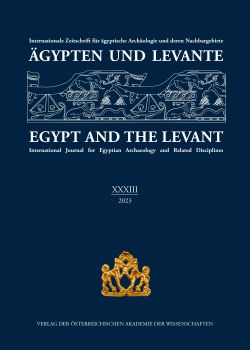Manfred BIETAK (Editor in Chief) - Ernst Czerny - Christiana Köhler - Nadine Moeller - Karol Myśliwiec (Eds.)
Ägypten und Levante XXXIII
Egypt and the Levant XXXIII
Internationale Zeitschrift für ägyptische Archäologie und deren Nachbargebiete
International Journal for Egyptian Archaeology and Related Disciplines
 Ivan V. Bogdanov
Ivan V. Bogdanov
S. 159 - 178
doi:
10.1553/AEundL33s159
Verlag der Österreichischen Akademie der Wissenschaften
doi:
10.1553/AEundL33s159
Abstract:
This article is a study of a new fragment of the architrave from Kom el-Akhdar, dating from the late Sixth to the Eighth Dynasty. H.G. Fischer previously published the right section of this architrave in 1976, while the left section ended up in the Rupert Wace gallery. The high-ranking official who owned the architrave was named nj -nDm=j -Xnmw. The monument is particularly interesting as a historical source for understanding the Old Kingdom administration in the Delta and the relationships between Egyptians and neighboring Semitic tribes. The left section of the architrave contains the ending of the main inscription, accompanied by images of the deceased seated on a chair, his son approaching with birds in hand as an offering, his second wife (or daughter) standing behind him, and a dwarf under the chair. The first part of this study includes a transcription and translation of all the inscriptions, as well as a grammatical commentary on the conversation between the butchers in the scene depicting the slaughtering of an ox. The second part of the study will predominantly include a commentary on anthroponyms and notes on various titles. Special attention is paid to the grammatical structure of names with the nisba nj as the predicate: nj-nDm=j -Xnmw and nj-sw-xw=j. It is important to note that this article is a revised version of the original paper in Russian (Bogdanov 2022).
Old Kingdom Egypt, 6th Dynasty, 8th Dynasty, Ancient Egyptian monumental inscriptions, Egyptian Delta in antiquity, Old Egyptian language
Published Online:
2024/02/28 15:18:12
Object Identifier:
0xc1aa5576 0x003ed9c0
Rights:All rights reserved.For questions regarding copyright and copies please contact us by email.
Die Zeitschrift Ägypten und Levante wurde im Jahr 1990 von Manfred Bietak begründet, um den Forschungen zu den Kulturkontakten zwischen Ägypten und seinen Nachbarländern sowie der ägyptisch-kanaanäischen Hybridkultur, wie sie vor allem bei den österreichischen Ausgrabungen in Tell el-Dab’a zutage trat, eine Publikationsplattform zu bieten. Von Anfang an war die Zeitschrift international und interdisziplinär ausgerichtet. Das Themenfeld geht über die ursprüngliche Kernthematik weit hinaus und umfasst sowohl Vorberichte und Berichte zu archäologischen Grabungen in Ägypten und dem gesamten Vorderen Orient sowie Nubien und dem Sudan, wie auch Artikel zu allen Aspekten der ägyptischen und nahöstlichen Archäologie, Geschichts- und Kulturwissenschaft. Der Fokus liegt auf der pharaonischen Zeit, jedoch sind sowohl Beiträge zur Ur- und Frühgeschichte der genannten Regionen wie auch zur nachpharaonischen Antike möglich. Dazu wird ein weites Feld an naturwissenschaftlichen Themen abgedeckt, von Fragen der C14-Datierung über materialkundliche Untersuchungen bis hin zu archäobotanischen, archäozoologischen und anthropologischen Arbeiten.
Ägypten und Levante erscheint einmal jährlich im Druck und online. Die Redaktion ist bemüht, eingereichte Artikel möglichst zeitnah zu publizieren. Beiträge sind in Deutsch, Englisch oder Französisch einzureichen. Buchbesprechungen und Rezensionen werden nicht publiziert. Alle eingereichten Artikel werden einem internationalen peer-review Verfahren gemäß den Qualitätsstandards der Österreichischen Akademie der Wissenschaften unterzogen.
Egypt and the Levant was founded by Manfred Bietak in 1990 to provide a publication platform for the research on cultural contacts between Egypt and her neighbours. A focus of interest was the Egyptian-Canaanite fusion of cultures, which was mainly encountered at the site of Tell el-Dab’a during the Austrian excavations. From the beginning, the scope of the journal was international and interdisciplinary. The subject area has now been greatly expanded far beyond the original topics. It comprises reports and preliminary reports on archaeological excavations in Egypt and the entire Middle East including the Sudan, as well as articles dealing with all aspects of Egyptian and Near Eastern archaeology, history or cultural history. The main emphasis lays on the pharaonic period, but both contributions to prehistory of the said regions, and post-pharaonic periods may be accepted. In addition, a broad range of scientific topics is covered, including C14-dating, material analyses, archaeobotanical and archaeozoological studies as well as studies in physical anthropology.
Egypt and the Levant is published on an annual basis, both in print and online. Submitted articles are intended to be published in a timely manner. Manuscripts may be submitted in English, German or French. Book reviews are not accepted. All submitted articles are subject to international peer-review according to quality standards of the Austrian Academy of Sciences.



 Home
Home Print
Print
 References
References
 Share
Share
 Ivan V. Bogdanov
Ivan V. Bogdanov